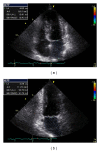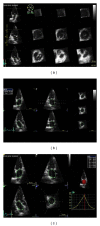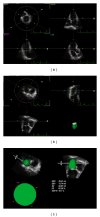Left atrium by echocardiography in clinical practice: from conventional methods to new echocardiographic techniques
- PMID: 25009828
- PMCID: PMC4070331
- DOI: 10.1155/2014/451042
Left atrium by echocardiography in clinical practice: from conventional methods to new echocardiographic techniques
Abstract
Although often referred to as "the forgotten chamber", compared with left ventricle (LV), especially in the past years, the left atrium (LA) plays a critical role in the clinical expression and prognosis of patients with heart and cerebrovascular disease, as demonstrated by several studies. Echocardiographers initially focused on early detection of atrial geometrical abnormalities through monodimensional atrial diameter quantification and then bidimensional (2D) areas and volume estimation. Now, together with conventional echocardiographic parameters, new echocardiographic techniques, such as strain Doppler, 2D speckle tracking and three-dimensional (3D) echocardiography, allow assessing early LA dysfunction and they all play a fundamental role to detect early functional remodelling before anatomical alterations occur. LA dysfunction and its important prognostic implications may be detected sooner by LA strain than by volumetric measurements.
Figures








Similar articles
-
Independent Echocardiographic Markers of Cardiovascular Involvement in Chronic Kidney Disease: The Value of Left Atrial Function and Volume.J Am Soc Echocardiogr. 2016 Apr;29(4):359-67. doi: 10.1016/j.echo.2015.11.019. Epub 2015 Dec 30. J Am Soc Echocardiogr. 2016. PMID: 26743735
-
Transthoracic 3D Echocardiographic Left Heart Chamber Quantification Using an Automated Adaptive Analytics Algorithm.JACC Cardiovasc Imaging. 2016 Jul;9(7):769-782. doi: 10.1016/j.jcmg.2015.12.020. Epub 2016 Jun 15. JACC Cardiovasc Imaging. 2016. PMID: 27318718
-
Early detection of abnormal left atrial-left ventricular-arterial coupling in preclinical patients with cardiovascular risk factors: evaluation by two-dimensional speckle-tracking echocardiography.Eur J Echocardiogr. 2011 Jun;12(6):431-9. doi: 10.1093/ejechocard/jer052. Epub 2011 May 15. Eur J Echocardiogr. 2011. PMID: 21576113
-
Clinical implications of left atrial function assessed by speckle tracking echocardiography.J Echocardiogr. 2016 Sep;14(3):104-12. doi: 10.1007/s12574-016-0283-7. Epub 2016 Mar 7. J Echocardiogr. 2016. PMID: 26951561 Review.
-
New echocardiographic techniques for evaluation of left atrial mechanics.Eur Heart J Cardiovasc Imaging. 2012 Dec;13(12):973-84. doi: 10.1093/ehjci/jes174. Epub 2012 Aug 21. Eur Heart J Cardiovasc Imaging. 2012. PMID: 22909795 Free PMC article. Review.
Cited by
-
Left atrial myocardial dysfunction after chronic abuse of anabolic androgenic steroids: a speckle tracking echocardiography analysis.Int J Cardiovasc Imaging. 2018 Oct;34(10):1549-1559. doi: 10.1007/s10554-018-1370-9. Int J Cardiovasc Imaging. 2018. PMID: 29790034
-
Realistic Aspects of Cardiac Ultrasound in Rats: Practical Tips for Improved Examination.J Imaging. 2024 Sep 6;10(9):219. doi: 10.3390/jimaging10090219. J Imaging. 2024. PMID: 39330439 Free PMC article. Review.
-
Early Echocardiographic Predictors for Atrial Fibrillation Propensity: The Left Atrium Oracle.Rev Cardiovasc Med. 2022 May 31;23(6):205. doi: 10.31083/j.rcm2306205. eCollection 2022 Jun. Rev Cardiovasc Med. 2022. PMID: 39077189 Free PMC article. Review.
-
Differentiation of the Left and Right Side Interventricular Septum Function in Healthy Subjects by Vector Velocity Imaging.Anatol J Cardiol. 2022 Apr;26(4):269-275. doi: 10.5152/AnatolJCardiol.2021.657. Anatol J Cardiol. 2022. PMID: 35435838 Free PMC article.
-
Three-Dimensional Echocardiography in Evaluating LA Volumes and Functions in Diabetic Normotensive Patients without Symptomatic Cardiovascular Disease.Int J Vasc Med. 2020 Aug 19;2020:5923702. doi: 10.1155/2020/5923702. eCollection 2020. Int J Vasc Med. 2020. PMID: 32922998 Free PMC article.
References
-
- Sirbu C, Herbots L, D’hooge J, et al. Feasibility of strain and strain rate imaging for the assessment of regional left atrial deformation: a study in normal subjects. European Journal of Echocardiography. 2006;7(3):199–208. - PubMed
-
- Donal E, Raud-Raynier P, Racaud A, Coisne D, Herpin D. Quantitative regional analysis of left atrial function by Doppler tissue imaging-derived parameters discriminates patients with posterior and anterior myocardial infarction. Journal of the American Society of Echocardiography. 2005;18(1):32–38. - PubMed
-
- Caso P, Ancona R, di Salvo G, et al. Atrial reservoir function by strain rate imaging in asymptomatic mitral stenosis: prognostic value at 3 year follow-up. European Journal of Echocardiography. 2009;10(6):753–759. - PubMed
-
- di Salvo G, Caso P, Lo Piccolo R, et al. Atrial myocardial deformation properties predict maintenance of sinus rhythm after external cardioversion of recent-onset lone atrial fibrillation: a color Doppler myocardial imaging and transthoracic and transesophageal echocardiographic study. Circulation. 2005;112(3):387–395. - PubMed
Publication types
MeSH terms
LinkOut - more resources
Full Text Sources
Other Literature Sources
Miscellaneous

